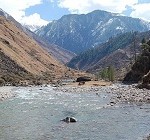Prime Minister Narendra Modi’s landmark bilateral visit to Nepal this week was marked by many successes – his speech in the Nepali parliament, his public walkabout, and aid to Nepal for its infrastructure needs, most specifically for hydropower.
Properly developed, electricity exports to India can be the cornerstone of Nepal’s economy – as in the case of neighbouring Bhutan. In July, Gateway House suggested that India use hydropower diplomacy to re-forge India-Nepal ties. It will help solve India’s electricity problems and most importantly, provide the country a renewable energy import from a friendly neighbour, overcoming our current reliance on non-renewable oil from volatile countries in West Asia.
This is exactly what Prime Minister Modi has expressed.
Nepal is a mountainous country with multiple rivers and an enormous hydropower potential of 43,000 mw [1]. Installed power generation capacity, however, is just 762 mw – insufficient to meet even domestic needs, leading Nepal to import electricity from India. This is in sharp contrast with much smaller Bhutan, which has twice the power generation capacity of Nepal. Bhutan’s electricity infrastructure was developed with Indian loans and grants, and it exports energy almost solely to India. New Delhi has already financed the construction of three power projects of 1,420 mw, and is currently helping build more. With Nepal, the cooperation has been restricted to four micro projects of just 51 mw.
There are some differences between the two Himalayan nations, which partly explain the differences in relationship. Bhutan is smaller and ethnically more homogenous compared to Nepal. It has also been politically much more stable – this has allowed long term investments starting from the 1980s.
Some challenges are obvious. Hydropower projects require large capital investments spread over several years. As a less prosperous economy, Nepal is not in a position to make such investments on its own and requires equity/debt assistance. However, no investor will engage with such a project unless there is a clear assurance from a buyer for purchasing power from the project. As a landlocked country with limited electricity demand, Nepal needs to look at export markets – in this case, India.
India’s relationship with Bhutan can be a model for improving its links with Nepal. In fact, Nepal is now trying to emulate Bhutan. At least three projects, with a total capacity of 2,400 mw, are being developed jointly with India. SJVN Limited, a joint venture of the Government of India and Himachal Pradesh, is developing the Arun-III 900 mw project in Nepal[2]. The private sector GMR Energy and GMR Infra Limited together with Nepal Electricity Authority and a third partner, have signed an agreement to develop the 900 mw Upper Karnali hydropower project [3]. Both MOUs were signed in 2008; it is not clear when the projects will be ready. The GMR Group has also acquired an 82% stake in the 600 mw Marsyangdi 2 Power Project; it is expected to be complete in 2021.
Survey licenses have also been issued to different private sector Indian firms such as GMR, Bhilwara Energy and KSK Energy for 26 hydropower projects with a combined capacity of 6,449 mw.
Given the current state of Nepal’s energy sector, India will have to assist in both building and buying, by providing financial assistance and signing long-term power purchase agreements. Nepal’s domestic politics are complicated, and India will have to ensure that the projects are not affected because of Nepal’s continuing political turbulence.
To ensure stability, Nepal can set up a politics-immune state-owned energy giant—like Bhutan’s Druk Green Power—as a partner in the projects with India. The price paid by India to Nepal for power must match the tariffs paid to Indian government-owned hydropower majors such as NHPC or SJVNL. India must ensure that it is not seen as taking advantage by offering low tariffs.
Investing in Nepal’s power sector will help India counter some of China’s considerable influence in that country. China is involved in at least two hydropower projects in Nepal—a 25 mw under-construction project, and a 750 mw project being developed by a subsidiary of the Three Gorges Corporation of China and funded by soft and commercial loans of $1.6 billion (Rs. 9,600 crore) by China’s Exim Bank. [4] & [5]
Amit Bhandari is the Energy and Environment Fellow at Gateway House.
This article was exclusively written for Gateway House: Indian Council on Global Relations. You can read more exclusive content here.
For interview requests with the author, or for permission to republish, please contact outreach@gatewayhouse.in.
© Copyright 2014 Gateway House: Indian Council on Global Relations. All rights reserved. Any unauthorized copying or reproduction is strictly prohibited
References:
[1] Central Electricity Authority. “Indo-Nepal Cooperation in Hydro Power Sector.” . http://www.cea.nic.in/reports/hydro/nepal.pdf (accessed July 29, 2014).
[2] SJVN Limited, Annual Report 2012-13<http://sjvn.nic.in/images/pdf/investor/SJVN_Annual_Report_2012-13_08_08_13.pdf>, p. 7
[3] Ministry of Energy, Government of Nepal, Memorandum of Understanding between the Government of Nepal, represented by Ministry of Water Resources and GMR-ITD Consortium, concerning the Execution of Upper Karnali Hydropower Project in Nepal, <http://www.moen.gov.np/pdf_files/MOU%20with%20GMRITD%20on%20Upper%20Karnali%20HEP.pdf>
[4] China International Water & Electric Corp, Upper Madi Hydroelectric Project, Nepal <http://english.cwe.cn/show.aspx?id=2795&cid=21>
[5] Global Times, Nepal seeks 400 mln USD soft loan from China to fund transmission line project <http://www.globaltimes.cn/content/855460.shtml>


